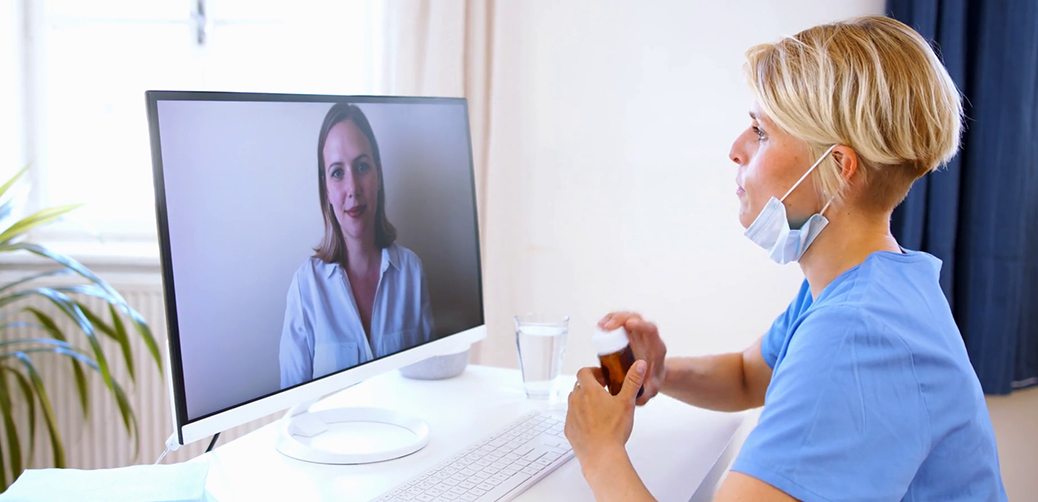Remote monitoring of patients is becoming the new normal. Read this blog to get prepared with telehealth.
The strain doctors have gone through during the pandemic is tremendous to even begin with. Their dedication was incredible, and they did emerge as true leaders and bravery icons of the healthcare industry.
With the pandemic, one more condition transformed, and it was the way (rather say the means) how healthcare professionals chose to check or treat their patients.
With pandemic hitting globally, the relationship between doctors and digital technology has strengthened. They have learned a lot about how the telemedicine and telehealth industry will be the future of their workplace.
However, the level of anxiety was not just limited to the workplace or the number of COVID cases that were being reported at their hospital, clinic, or society. Beginning to deal with telehealth brought a range of problems on the digital front for health workers. Governance issues and interoperability are just the major ones; introducing new management systems to deal with the crisis leads to a lot of chaos. Handling the management of training the healthcare executives, dealing with cybersecurity, data management, and speed of deployment/session, altogether added to anxiety levels amongst the doctors.
Although Telehealth was here for a long time, we as people did not prefer it. But the times have changed, and we all are avoiding or say restricting ourselves from visiting public places, right!
Telemedicine and remote patient monitoring are now taking the main seat, along with patients, all major health institutions and healthcare experts are planning to build systems that can work in current times.
With these remote monitoring or telemedicine systems, it’s crucial for the associated workforce to adjust to the new flow of information, understand the modern IT requirements, educating the patients, manage a new digital stream of data, safeguard security, and much more.
Let’s this a few of the top issues that are to be dealt with in thriving this new normal of the healthcare industry:
- Managing the Massive Data
There would be a tsunami of data once we begin with telemedicine services on a global level. There would be a flexibility of patients being diagnosed from every part of the world. This upsurge in the new data and types of data will obviously demand to be dealt with.
Your healthcare application must be efficient in managing your electronic health records.

- Securing the Data
With any service operated digitally, there comes a risk of security. Being cyber secure with any remote healthcare monitoring system emerges to be one of the most significant factors to work upon in its contingency plan.
Safeguarding the data and information on both the provider and patients side is of utmost importance.
- Optimizing the RPM for Physicians
Remote patient monitoring can be further optimized in a number of ways by the clinicians to deliver the desired care to the patients at their homes. There are already numerous functionalities and features being discussed that can be embedded in the newly connected health tools and data management tools to make RPM work effectively.
Shaping the right strategies with modern remote monitoring tools is what our physicians or doctors must aim for!
- Training Employees for future
There’s an imperative need to cultivate the culture of digitally monitoring and diagnosing the patients; it’s for both the provider and patient’s safety and flexibility. With new technologies, approaches, and processes being introduced in the field, it becomes essential to manage the workforces better to meet the modern healthcare service standards.
Proper training of employees will lead to achieving new telehealth demands and make the best out of virtual care processes.
- Surfing through new policies
There have to be some regulations to realize telehealth services on a global level. Although the Centers of Medicine & Medicaid Services have presented a wide latitude around telehealth regulation and reimbursement in the pandemic’s initial days, how much of it will be followed and be flexible is yet to be seen.
There will definitely be some policies introduced around payment parity.
Conclusion
While realizing a remote monitoring system in current times, there are various lessons to be learned. However, we must learn them fast. This new era of healthcare will bring cognitive dissonance in the relationship between digital technologies and doctors.
Finally, we hope to witness and access healthcare systems customized to patients’ specific needs.
At SoftGrid Computer Indore, we possess technical expertise and skills to build a dedicated Telemedicine delivery system for an individual or a healthcare organization. Our team of proficient web developers can help you in designing customized hospital management softwares integrated with third-party systems and telemedicine services to gain an edge over your competitors.
Contact us to learn more about how we can build a healthcare software for you!

 Web and Full Stack
Web and Full Stack CMS and Frameworks
CMS and Frameworks Online Marketing
Online Marketing Cloud Services
Cloud Services ECommerce
ECommerce Mobile
Mobile



